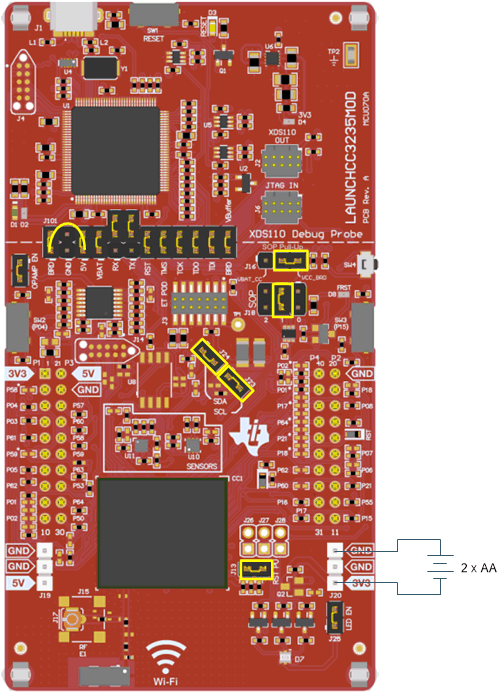SWRU548C February 2019 – September 2021 CC3235MODAS , CC3235MODASF , CC3235MODS , CC3235MODSF
- 1Introduction
-
2Hardware
- 2.1 Block Diagram
- 2.2
Hardware Features
- 2.2.1 Key Benefits
- 2.2.2 XDS110-Based Onboard Debug Probe
- 2.2.3 Debug Probe Connection: Isolation Jumper Block
- 2.2.4 Application (or "Backchannel") UART
- 2.2.5 JTAG Headers
- 2.2.6 Using the XDS110 Debug Probe with a Different Target
- 2.2.7 Power Connections
- 2.2.8 Reset Pullup Jumper
- 2.2.9 Clocking
- 2.2.10 I2C Connection
- 2.2.11 Sense on Power (SOP)
- 2.2.12 Push-Buttons and LED Indicators
- 2.3 Electrical Characteristics
- 2.4 Antenna Characteristics
- 2.5 BoosterPack Plug-in Module Pinout
- 3Layout Guidelines
- 4Operational Setup and Testing
- 5Development Environment Requirements
- 6Additional Resources
- 7Assembly Drawing and Schematics
2.2.7.2 BoosterPack Plug-in Module and External Power Supply
Headers J19 and J20 are present on the board to supply external power directly when USB power is not available. Use the following precautions before using the board with an external power supply.
- Remove the USB cable.
- Ensure that jumpers are only placed on the headers shown in Figure 2-11.
- Use a jumper wire to connect VBAT and BRD.
- Plug in the external power supply on J20 with the correct polarity.
 Figure 2-11 Powering the CC3235MODSF LP from an External Power Supply
Figure 2-11 Powering the CC3235MODSF LP from an External Power SupplyThe OPAMP EN and LED EN jumpers are also available to remove any current draw from the onboard OpAmp and LEDs being driven by the GPIOs, see Table 2-2.
Table 2-2 External Supply Connections and Enable Jumpers
| Reference | Use | Comments |
|---|---|---|
| J19 | 5-V power input | Used to power the board from an external 5-V supply |
| J20 | 3.3-V power input | Used to power the board from an external 3.3-V supply. |
| J21 | OPAMP EN | If uninstalled, the power supply to the operational amplifier is cut off. This can be used to enable low-power measurements. |
| J26 | LED EN | If uninstalled, the LEDs connected to the GPIO are disabled; this can be used to enable low-power measurements. |